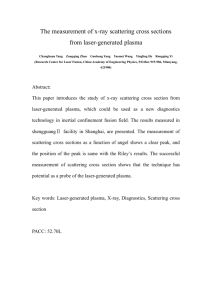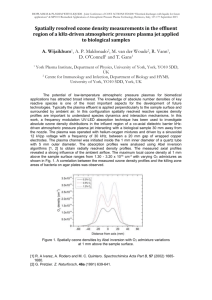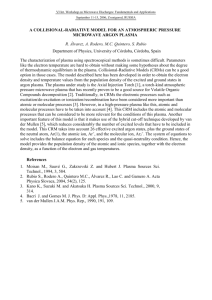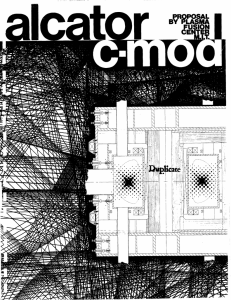Performance of Alcator C-Mod
advertisement
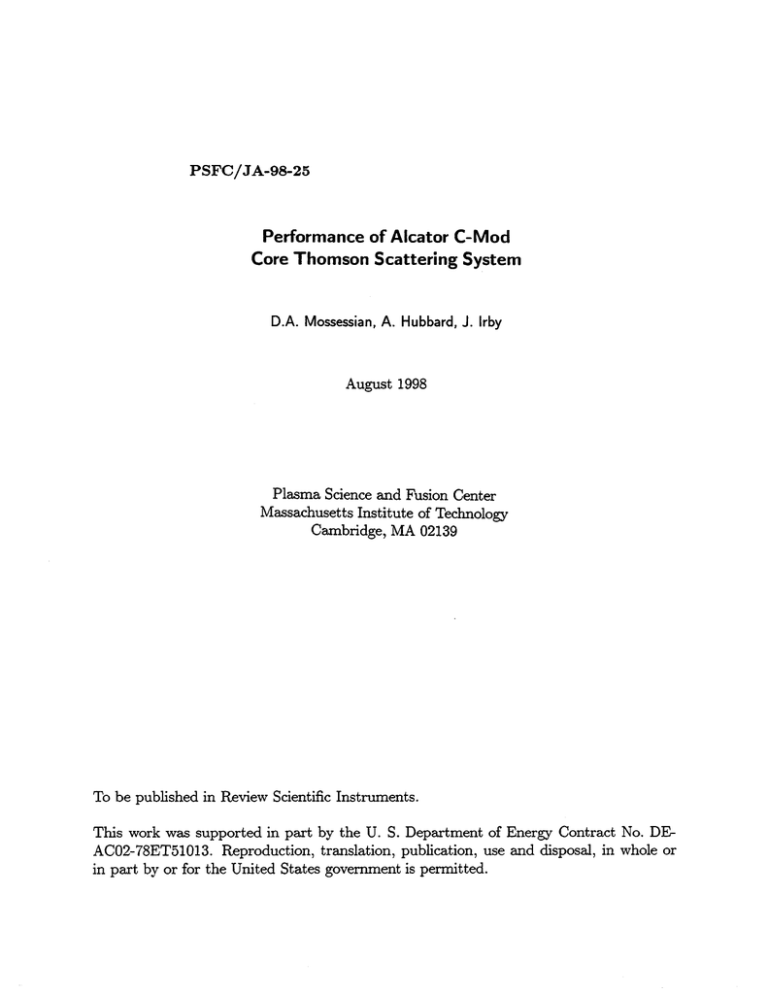
PSFC/JA-98-25 Performance of Alcator C-Mod Core Thomson Scattering System D.A. Mossessian, A. Hubbard, J. Irby August 1998 Plasma Science and Fusion Center Massachusetts Institute of Technology Cambridge, MA 02139 To be published in Review Scientific Instruments. This work was supported in part by the U. S. Department of Energy Contract No. DEAC02-78ET51013. Reproduction, translation, publication, use and disposal, in whole or in part by or for the United States government is permitted. Performance of Alcator C-Mod Core Thomson Scattering System. D.A.Mossessian, A.Hubbard, J.Irby Plasma Science and Fusion Center, Massachusetts Institute of Technology, Cambridge, Massachusetts 02139 Abstract Design of the Alcator C-Mod Thomson Scattering (TS) diagnostic is discussed and the results of the measurements are presented. The TS system has 6 spatial channels with observation volumes evenly distributed between the midplane and the edge of the plasma. Each channel is capable of measuring the electron density in the range Ne = 5x 1019 m-3 - 5x 1021 m-3 and temperature from Te = 200 eV - 10 keV. A 30 Hz, 1.5 J per pulse Nd:YAG laser is employed allowing the measurements of evolution of Te and Ne yrofiles during plasma shot. A laser beam position control and feedback system provides for the beam alignment stability and reliable electron density measurements. Examples of the core density and temperature profiles measured at different stages of the plasma evolution are discussed. I Introduction In this article we describe Thomson Scattering (TS) measurements of the electron temperature and density of Alcator C-Mod plasmas. The TS diagnostic based on a high repetition rate Nd:YAG laser is designed to record time evolution of electron temperature and density profiles in the core of the tokamak plasma. The design of the TS diagnostic system was presented in detail previously [1,2]. Here we describe briefly the main features of the diagnostic and present several examples of recently obtained results that characterize the diagnostic's performance.. To produce electron density measurements a TS system has to be able to measure the absolute intensity of the scattered light. Although no direct absolute calibrations of the system have been performed so far, all spatial channels were cross calibrated with the results of Two Color Interferometer (TCI) diagnostic [3]. This calibration is dependent on certain assumptions about the density profile in the plasma. However, comparison with results of other diagnostics and analysis of the time evolution of measured density profiles indicate, as discussed below, that this method of calibrations is quite reliable. The electron temperature measurements were compared with the results of Electron Cyclotron Emission diagnostic showing good agreement. Thus we were able to record the time evolution of density and temperature profiles during various stages of a C-Mod plasma shot. The measured Ne and T, profiles during L, H and PEP modes, and at L-H and H-L transitions will be discussed. System description and data analysis procedure The core TS diagnostic in Alcator C-Mod measures the electron temperature and density at 6 spatial locations in the plasma along the vertical axis of the vacuum vessel (see Fig. 1). The diagnostic employs the first harmonic (X=1.064 gm) of the Continuum PowerLight 9030 Nd:YAG laser with 1.5 J pulse energy, 10 nsec pulse duration, and repetition rate of 30 Hz. The 2 Nd:YAG beam is combined with a HeNe alignment beam and steered down a vertical port of the tokamak. The beam passes through the plasma close to the magnetic axis and is absorbed by the beam dump after it exits the machine through the bottom port. The ND:YAG beam is focused at the center of the vacuum chamber by a 3 m focal length doublet so that its cross section is less than 2 mm over the entire path of the beam through the plasma. A portion of the Nd:YAG light leaking through one of the steering mirrors is used to generate the trigger and gate pulses for data acquisition system. The data acquisition system is based on CAMAC standard and driven by software operating under the MDS-PLUS data acquisition platform [4] on VAX/VMS architecture. The Nd:YAG laser flashlamps and Q-switch pulses are supplied by the CAMAC pulse generator, and the laser timing is controlled through the MDS-PLUS system. The initial alignment of the system is carried out by inserting alignment targets (see Fig. 1) into the beam path and observing the image of the HeNe alignment beam on the collection fiber bundles. During plasma operation, the position of the HeNe beam before the focusing optics is measured by a position sensitive detector (PSD). The signal from PSD is analyzed by a computer and the correction signals are send to the piezo actuators on the steering mirrors thus closing the active feedback loop. Collinearity of the HeNe and Nd:YAG beams is controlled by video cameras looking at the beams near the entrance windows of the top and bottom ports. The Nd:YAG beam can be steered remotely independent of the HeNe beam to correct for any misalignment. Another video camera is used to observe the position of the laser beams at the beam dump. Thus, the alignment of the system can be controlled and corrected in real time during plasma run. The scattered light is collected by an f/7 Cooke triplet (collection solid angle 1.5x1 0-2) which is designed to produce an aberrationless image of an entire laser beam path in the plasma (± 30 cm vertical distance) with 1:2 demagnification. The height of observation volumes of individual spatial channels are defined by the input apertures of the collection fibers in the image plane of the lens system. Six fiber bundles are used in the present system, placed in the image 3 plane so that the observation scattering volumes are distributed in the range from -26 cm to + 22 cm around the center of the vacuum chamber (see Fig. 1). The height of each observation volume is 20 mm. Each fiber bundle couples scattered light to the entrance slit of a 9 channel grating spectrometer. The light in each spectral channel is recorded by a silicon avalanche photodiode. The signal of the photodiode is amplified by a low noise high gain preamplifier and is recorded by a gated digitizer. The intensity of TS radiation per unit wavelength is proportional to the product of plasma density Ne and a spectral density function S(k,co) [5]. The shape of the spectral density function is determined by the electron temperature. Thus the integral TS intensity depends only on the electron density and the ratios of the signals in spectral channels depend only on electron temperature. Since the relativistic effects become important for T_>2 keV and the temperature in the plasma core of Alcator C-Mod can be as high as 5 keV, the relativistic spectral density function is used for data analysis as given in [6]. The spectral width of the spectrometers' channels varies from 100 A to 500 A and the spectral response of the detection system is nonuniform inside each channel. Therefore, the convolution of the S(k,k) function with instrument functions of the spectral channels f1(X) is used for fitting the data. To obtain electron temperature, the ratios of the signals in each spectral channel to the signal in the first channel are fitted with the precalculated ratio JS(k,1)f1 (X)dX f S(k, k)f, (X)dX as a function of Te. The electron density is then calculated using the result of the absolute calibration of the system. Calibration and comparison with other diagnostics To make plasma density measurements a Thomson scattering system requires a calibration which is usually done using Raman or Rayleigh scattering in a known medium. In 4 this TS system the high level of stray light and observed irregular changes of the stray light intensity during and between laser bursts makes it impossible to carry out reliable Rayleigh scattering calibrations. It also prevents us from performing the Raman scattering calibrations since the Raman intensities are very low and the detected Raman signal is comparable to the unrejected stray light and Rayleigh scattering signals. It should be noted that the unrejected stray light does not affect the Thomson scattering measurements since its level amounts only to 2 to 3 percent of the TS signal. To obtain absolute density measurements, the TS signal was cross calibrated with the results of the Two Color Interferometer (TCI) diagnostics. The TCI measures line integrated densities along several vertical chords in the plasma. To obtain a local density value from these measurements certain assumptions have to be made about the radial density profile of the plasma. For cross calibrations we have chosen the TCI measurements of the densities during steady state enhanced D. H mode (EDA) [7,8]. This mode is characterized by increased plasma core density, steady state levels of density, stored energy, and radiated power, and a sharp density gradient at the plasma edge. Since the transport barrier in H mode develops at the plasma edge, the core density profile can be assumed flat during the steady state. Then the central plasma density can be calculated by dividing the TCI line integrated density by the length of the TCI chord limited by the last closed flux surface. The TS channels were calibrated using this density value on every shot when the steady state EDA mode was observed. The calculated scatter of the calibration coefficients around their averages over a two month run period is less than ± 10%. This testifies to stability of the alignment of the TS system. The errors of the TCI measurements of the line averaged density are of the order of 1%. Therefore, the uncertainties of the TS density values obtained by this method of calibration results mainly from deviation of assumed density profile from the real one. The obtained calibrations can be checked by comparing the TS measured profiles with the profiles obtained by inversion of the TCI measurements. The inversion algorithm used to obtain density profiles from TCI results requires minimization of the second derivative of the 5 density profile at each evaluated point and therefore always results in a smooth density profile [3]. Thus it can be expected to produce best results when applied to the measurements during an L mode when no sharp density gradients form in the plasma or at the plasma edge. The results of the comparison of the TS profile and the TCI inversion during L mode are shown in Fig. 2. Also shown are the profiles measured at H mode. The agreement is usually very good for L mode measurements. Another independent check of the measured density values can be done by analyzing the Electron Cyclotron Emission signal that is used for electron temperature measurements [9]. The ECE diagnostic has nine channels each tuned to a certain frequency and thus observing the radiation from a location in the plasma characterized by a given magnetic field. When electron density at that location rises above a critical value the plasma cutoff is seen in the ECE signal. To compare the TS measured densities and the known critical densities, the TS profile has to be interpolated in time and space to the point where the cutoff is observed. Since the cutoff is usually observed during a nonlinear stage of development of the density profile (L - H transition, pellet injection) no exact comparison can be made. However, the interpolated TS densities are found to be always within ±15% range around the calculated cutoff density, which is in reasonable agreement with the ±10% error bar obtained from the TS - TCI cross calibrations. Results In this section we present several examples of the TS measurements of the electron temperature and density profiles in Alcator C-Mod. The recorded evolution of the profiles during the L - H and H - L transitions and during PEP mode is discussed. The electron temperature and density measured by six TS channels during a steady state EDA H mode discharge are shown in Fig. 3. The temperatures are plotted together with the results of the ECE diagnostics. 6 Since the ECE polychromator views the plasma along the midplane, to compare the ECE measurements with the TS temperatures the former had to be interpolated to the TS profile mapped to the midplane. Using the EFIT code he flux surfaces are found which pass through the centers of the TS observation volumes. Assuming that the temperature and density are constant along a flux surface, the midplane radii of the found surfaces are used to construct the temperature and density radial profiles. Then the ECE results are linearly interpolated to the midplane TS radii. The flux surfaces mapping errors and nonlinearity of the profiles near the edge may account for a larger discrepancy between the ECE and TS data at the outer TS channel. The L-H transition can be seen around 0.6 sec, indicated by a fast increase in temperatures and densities in all channels. After approximately 100 ms the density profile achieves the steady state that lasts for 0.5 sec during the RF pulse. When the heating RF pulse ends the H mode collapses into the L mode, but before the collapse a small peak in central density is observed. In Fig. 4 the evolution of density and temperature profiles is shown during the L - H transition. During the transition the transport barrier is formed at the plasma edge resulting in a strong increase in the edge temperature and density [7]. As seen in Fig. 4 a hollow density profile is formed resulting from faster density increase near the edge. The profile flattens when the steady state H mode is achieved. The electron temperature increases faster then density, achieving a steady state profile in less than 30 ms (time resolution of the TS). At the H - L transition the picture is reversed. Traces of the TS measured central density, central TCI line averaged density, De intensity and RF heating power are shown in Fig.5, together with TS density profiles. After the end of the heating RF pulse, the electron density continues to increase as seen both on the TS and line averaged density traces in Fig. 5 a. However, the line averaged density is increasing slower than the central density, resulting from nonlinear changes of the density profile. While the central density continues to rise for a short 7 period of time after the H - L transition, indicated by a peak in the Da intensity, the line average density falls sharply at the moment of the transition. This results from the sharp decrease of the density near the edge, as shown in Fig. 5b. In this figure the profiles from two similar shots are shown in which the timing of the TS was shifted relative to the moment of the H -L transition. The timing of each profile relative to the transition is shown on the graph. It is seen that the electron density near the edge falls sharply immediately after the H -L transition, while the central density is growing for several tens of milliseconds and then decreases gradually to the L mode level over - 50 ms. This effect can also be observed on electron temperature profiles (Fig. 6) although it is not as pronounced as in case of the density. This results in peaking of electron pressure profiles after the H - L transition (see Fig.6) Another example of the evolution of Te , N. and electron pressure profiles measured by Thomson scattering is shown in Fig.7. There the profiles measured during the Pellet Enhanced Performance (PEP) mode [10] are presented. In the case we consider here the PEP mode is created when a lithium pellet is injected into the plasma creating a peaked density profile followed by ICRF heating. The resulting profiles are shown in Fig. 7. The time indicated for each profile is a time difference between the TS laser pulse and the moment of pellet ablation seen as a spike in Da signal. The L mode profiles are observed before the pellet injection with central density around 2. 1020 m- and temperature around 1.5 keV. The injection leads to a sharp increase in plasma density (to almost 101021 m-) and decrease of temperature to 500 eV. The unchanged value of the density in the central TS channel may result from the pellet missing the plasma center or being ablated before it reaches the center. Because of the cooling of the plasma the electron pressure profile does not change much at that time. In this shot the ICRF heating begins at about 30 ms after the pellet ablation. Increasing electron temperature can be seen on the third profile (30 ms) together with sharply peaked density profile. This results in peaking of the pressure profile that continues for next 60 ms as the central electron temperature increases to 3 keV. 8 Conclusions and future plans The six-channel core Thomson scattering system on Alcator C-Mod is fully operational and produces reliable measurements of the electron temperature and density. The developed method of cross calibration with the Two Color Interferometer diagnostics allows the density profiles to be recorded with good accuracy. However, a systematic error can be present in the density measurements if the density profile during the steady state H mode is not flat as assumed during calibrations. Clearly the absolute calibration of the system is necessary and will be carried out in the near future. To accomplish this calibration we need to reduce the stray light level and to understand the nature of its irregular changes. Addition of several new channels is planned to extend the profile measurements to the plasma edge. 9 References 1. Reich Watterson, Kuo-in Chen, Rev. Sci. Instrum. 61, 2867 (1990) 2. 2. J. A. Casey, R. Watterson, F. Tambini, E. Rollins, and B. Chin, Rev. Sci. Instrum. 63 4950 (1992) 3.J.H. Irby, E.S. Marmar, E. Sevillano, and S.M. Wolfe, Rev. Sci. Instrum. 59, 1568 (1988). 4. J.A.Stillerman, T.W.Fredian, K.A.Klare, G.Manduchi. Rev. Sci. Instrum. 68, 939 (1997). 5.J. Sheffield, Plasma Scattering of Electromagnetic Radiation, Academic Press, NY (1975) 6. A. C. Selden, Phys. Lett. A 79, 6 (1980) 7. M. Greenwald et al Nuclear Fusion, 37, 793 (1997) 8. Y.Takase et al. Phys. Plasma 4, 1647 (1997) 10. D.T.Garnier et. al. Proceedings of the Sixteenth International Conference on Fusion Energy, 907, (1997) 9. P.J.O'Shea, A.E.Hubbard and Alcator C-Mod Group. Proceedings of the Ninth Joint Workshop on Electron Cyclotron Emission, 393 (1995) 10 Figure captions. Fig. 1 Layout of the Alcator C-Mod core Thomson scattering diagnostics Fig.2 Density profiles measured by Thomson scattering and obtained by inversion of the Two Color Interferometer results Fig.3 Measured traces of electron temperature and density for a steady state enhanced D, H mode. Temperatures measured by Electron Cyclotron Emission diagnostic are shown (solid lines) Fig.4 Recorded evolution of density and temperature profiles during L - H transition Fig.5 Changes of density profile during H - L Fig.6 Evolution of temperature profile and peaking of electron pressure during H - L transition Fig.7 Evolution of temperature, density and pressure profiles at Pellet Enhanced Performance mode 11 camera I & PSD laser beam alignment targets fibers to spectrometers vacuum window Pcamera 2 Fig.1 -- beamn dump D.Mossessian, Performance of the Alcator C-Mod Core Thomson Scattering System 12 4x1 02 - 3.53SL mode A 2.5_ - z. H mde TCI inversion 21.51 - 0.50.0 0.2 0.6 0.4 0.8 1.0 r/a Fig.2 D.Mossessian, Performance of the Alcator C-Mod Core Thomson Scattering System 13 Z 0.4 0.8 1. r/a=0.14 22 2.0 1.0 40 - 0.4 0.8 1.2 r/a=0. 0.4 0.8 1.2 r/a=0.72 0. 812 04 08 1.2 04 08 1.2 04 08 1.2 1.04 2.0- 2 1.0 0 0.4 0.8 1.2 4 1.10r/a=0.82 2.0- - 1.0 0.0 S20.4 0.8 1.2 Time (sec) 0.4 0.8 1.2 Time (sec) Fig.3 D.Mossessian, Performance of the Alcator C-Mod Core Thomson Scattering System 14 2.5- 2.0 I-1.00.5 0.0 ___ 0.8 0.6 0.4 0.2 r/a 20 3.5x102A ....................... ....... ........ 3-T ........................... A 2.5 T-- - --. 0.55 sec 0.64 sec 0.67 sec 0.91 sec ... E)---_ 1.5-_ 0.0 _ _ 0.2 _ _ _ _ __ _ 0.6 0.4 _ _ _ 0.8 _ _ _ _ 1.0 r/a Fig. 4 D.Mossessian, Performance of the Alcator C-Mod Core Thomson Scattering System 15 a N. 0 (TS) 2.5Ne (TCI) 10' 0H RF net power 0.0 1.15 1.20 1.25 1.30 1.35 Time (sec) 1.40 1.45 1.50 b 4x1020 - z 3.5 3- - 2- Time after H - L transition (ms) 1. -k-10 --6- 34 --G-- 43 I I IT 0.0 0.2 0.4 0.6 0.8 1.0 r/a Fig. 5 D.Mossessian, Performance of the Alcator C-Mod Core Thomson Scattering System 16 1.6- a- 1.4- Time after H - L transition 1.2- .-&- -10 Ms ----- 20 ms 1.0- A-- 50 ms - -- 80 ms 0.8- -0 0.6- -.............................. 0.40.2I 0.2 1 0.4 0.6 Time (sec) 1.0- 0.8 0.8- 0.6z .. 0.40.20.0 I 1 I 0.2 0.4 0.6 0.8 r/a Fig. 6 D.Mossessian, Performance of the Alcator C-Mod Core Thomson Scattering System 17 1x1021 - 0.8E0.6 - 0.4- 3.0- 0.72 0.84 0.80 0.76 2.01- 1.0- 0.00.72 0.84 0.80 0.76 1.0 r/a 0.8- Time from pellet (ms) 0.6- -- -- -- .4, 2 0.4-- -30 30 60 90 0.20.00.72 0.80 0.76 0.84 r/a Fig. 7 D.Mossessian, Performance of the Alcator C-Mod Core Thomson Scattering System 18

